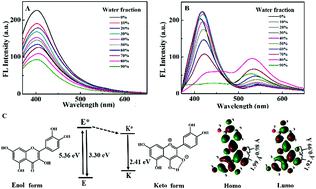当前位置:
X-MOL 学术
›
J. Mater. Chem. C
›
论文详情
Our official English website, www.x-mol.net, welcomes your feedback! (Note: you will need to create a separate account there.)
A natural hyperoside based novel light-up fluorescent probe with AIE and ESIPT characteristics for on-site and long-term imaging of β-galactosidase in living cells
Journal of Materials Chemistry C ( IF 6.4 ) Pub Date : 2020-07-20 , DOI: 10.1039/d0tc01981j Ruiqing Long 1, 2, 3, 4, 5 , Cui Tang 3, 6, 7, 8, 9 , Zan Yang 2, 5, 10, 11 , Qiachi Fu 1, 2, 3, 4, 5 , Jinju Xu 1, 2, 3, 4, 5 , Chaoying Tong 1, 2, 3, 4, 5 , Shuyun Shi 1, 2, 3, 4, 5 , Ying Guo 3, 6, 7, 8, 9 , Daijie Wang 5, 12, 13, 14, 15
Journal of Materials Chemistry C ( IF 6.4 ) Pub Date : 2020-07-20 , DOI: 10.1039/d0tc01981j Ruiqing Long 1, 2, 3, 4, 5 , Cui Tang 3, 6, 7, 8, 9 , Zan Yang 2, 5, 10, 11 , Qiachi Fu 1, 2, 3, 4, 5 , Jinju Xu 1, 2, 3, 4, 5 , Chaoying Tong 1, 2, 3, 4, 5 , Shuyun Shi 1, 2, 3, 4, 5 , Ying Guo 3, 6, 7, 8, 9 , Daijie Wang 5, 12, 13, 14, 15
Affiliation

|
Fluorescence-based on-site and long-term sensing and bioimaging of biomarkers are highly desired for effective diagnosis. Aggregation-induced emission luminogens (AIEgens) with excited-state intramolecular proton transfer (ESIPT) characteristics have outstanding advantages in biological applications due to their large Stokes shift and low background signal in the aggregate state. However, most of the reported AIEgens are fabricated through rational design and complex synthesis procedures. Importantly, with rich structural skeletons and ease of access, natural products have superiority in developing promising AIEgens with ESIPT. Here, hyperoside(quercetin-3-O-β-galactoside) has been easily obtained from Hedyotis diffusa. After the incubation of hyperoside with β-galactosidase (β-Gal), the hydrolysis product, hydrophobic quercetin, is aggregated in situ, which presents AIE and ESIPT characteristics with a large Stokes shift (170 nm). Then, a novel light-up fluorescent probe has been fabricated for the detection of β-Gal with a good linear relationship (0.03–12 U mL−1), high sensitivity (a detection limit of 0.013 U mL−1) and superior selectivity. Meanwhile, excellent biocompatibility, low cytotoxicity, outstanding photostability, and good intracellular retention demonstrate its superiority for on-site and long-term (about 8 h) imaging of β-Gal in SKOV-3 cells. The results demonstrate the application of hyperoside in the sensing and imaging of β-Gal in biological samples, and propose the great possibility of natural products for developing novel AIE-based fluorescence probes.
中文翻译:

一种基于天然高丝苷的新型发光荧光探针,具有AIE和ESIPT特征,可对活细胞中的β-半乳糖苷酶进行现场和长期成像
为了有效诊断,非常需要基于荧光的生物标记物的现场和长期感测以及生物成像。具有激发态分子内质子转移(ESIPT)特性的聚集诱导发射发光剂(AIEgens)在生物应用中具有突出的优势,因为它们的斯托克斯位移大且聚集态的背景信号低。但是,大多数报道的AIEgens是通过合理的设计和复杂的合成程序制造的。重要的是,凭借丰富的结构骨架和易于接近的特性,天然产物在利用ESIPT开发有前途的AIEgens方面具有优势。在这里,容易从白花蛇舌草中获得hyperoside(槲皮素-3- O -β-半乳糖苷)。将高糖苷与β-半乳糖苷酶(β-Gal)孵育后,水解产物疏水性槲皮素原位聚集,表现出具有大Stokes位移(170 nm)的AIE和ESIPT特征。然后,制备了一种新型的发光荧光探针,用于检测具有良好线性关系(0.03–12 U mL -1),高灵敏度(检测限为0.013 U mL -1)的β-Gal。)和优越的选择性。同时,出色的生物相容性,低细胞毒性,出色的光稳定性和良好的细胞内滞留性证明了其对于SKOV-3细胞中β-Gal的现场和长期(约8小时)成像的优越性。结果证明了金丝桃苷在生物样品中β-Gal的传感和成像中的应用,并提出了天然产物用于开发新型基于AIE的荧光探针的巨大可能性。
更新日期:2020-09-03
中文翻译:

一种基于天然高丝苷的新型发光荧光探针,具有AIE和ESIPT特征,可对活细胞中的β-半乳糖苷酶进行现场和长期成像
为了有效诊断,非常需要基于荧光的生物标记物的现场和长期感测以及生物成像。具有激发态分子内质子转移(ESIPT)特性的聚集诱导发射发光剂(AIEgens)在生物应用中具有突出的优势,因为它们的斯托克斯位移大且聚集态的背景信号低。但是,大多数报道的AIEgens是通过合理的设计和复杂的合成程序制造的。重要的是,凭借丰富的结构骨架和易于接近的特性,天然产物在利用ESIPT开发有前途的AIEgens方面具有优势。在这里,容易从白花蛇舌草中获得hyperoside(槲皮素-3- O -β-半乳糖苷)。将高糖苷与β-半乳糖苷酶(β-Gal)孵育后,水解产物疏水性槲皮素原位聚集,表现出具有大Stokes位移(170 nm)的AIE和ESIPT特征。然后,制备了一种新型的发光荧光探针,用于检测具有良好线性关系(0.03–12 U mL -1),高灵敏度(检测限为0.013 U mL -1)的β-Gal。)和优越的选择性。同时,出色的生物相容性,低细胞毒性,出色的光稳定性和良好的细胞内滞留性证明了其对于SKOV-3细胞中β-Gal的现场和长期(约8小时)成像的优越性。结果证明了金丝桃苷在生物样品中β-Gal的传感和成像中的应用,并提出了天然产物用于开发新型基于AIE的荧光探针的巨大可能性。


























 京公网安备 11010802027423号
京公网安备 11010802027423号